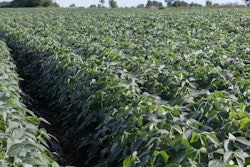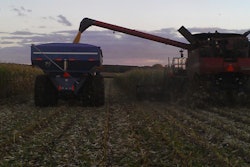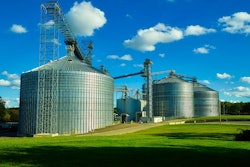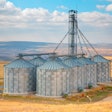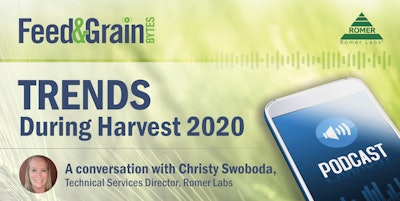
Welcome to Feed&Grain BYTES, our inaugural episode features Romer Labs' Christy Swoboda, technical services director. Listen to the podcast below as Christy discusses harvest 2020 and the mycotoxin trends she's seeing this fall.
Sponsored by:
_NEW.jpg?auto=format%2Ccompress&fit=max&q=70&w=400)
Feed&Grain BYTES transcript
Mycotoxin Trends During Harvest 2020
Lisa Cleaver:I'd like to welcome everyone to the premiere of Feed & Grain BYTES, our new podcast that will cover topics important to the feed and grain industry. I’m Lisa Cleaver with Feed & Grain magazine, and today we have Christie Swoboda, technical services director with Romer Labs, here with us to discuss harvest 2020 and mycotoxin trends. Welcome, Christy!
Christy Swoboda:Hello!
Cleaver: I’m just going to dive right in with our first question. At this time of year, what type of commodities do you typically see submitted to the lab for mycotoxins analysis?
Swoboda:As we move into harvest completion, even across the U.S., at first we see a lot of raw grains come into our lab. We see corn, wheat, rye, soybeans and so on. It helps to get indications of what to expect.
As harvest season moves on, we start to keep trends of what type of contamination levels that were repeatedly being detected. That helps us start to regionalize those mycotoxin concerns year to year – what mycotoxin issues arise on that geographical regional basis.
As we know, mycotoxins don't impact the entire crop across the whole U.S., so understanding where the best grain is coming from and where there might be mycotoxins issues is good for us to know.
As the season does progress, we see a change in those samples as they move into more complex feed ingredients or even final product.
So we start to see a lot of samples like TMRs, which are those total mixed rations, corn gluten feed, corn gluten pellets, feed samples themselves. We start seeing complex finished products coming in as that new crop starts to be put into feed production.
Cleaver: Can you explain how mycotoxins testing is conducted in the grain industry?
Swoboda:When I first started in the mycotoxin testing industry, which is about 18 years ago now, our analytical lab primarily focused on testing those raw grains. We really did most of our work specifically in corn, wheat, soybean and rice.
Over the years, especially the past five maybe going back as far as 10 years, the mycotoxin testing industry shifted from really using reference testing, which is something like an analytical lab does, to using a rapid test kit, such as those lateral flow testing devices in order to test the raw grain.
A lot of the raw grain testing is moving away from an analytical lab and more into diagnostic test kits. As a result, our labs focus more on the complex side of feed ingredients and feed products.
The diagnostic test kits over the last several years have greatly improved both in their reliability and accuracy in detecting mycotoxins. Many of them are now validated against lab reference methods, and they even seek external validation.
If those tools have become better, customers are bringing the testing of those raw grains on to their site at their facility – be it a grain elevator or grain terminal, ethanol facility, ingredient manufacturer -- even the feed manufactured and the pet food manufacturer.
All of those doing that testing on site has meant they have an immediate decision as far as accepting the grain, rejecting the grain, or really diverting it into a different product based upon what the mycotoxins contamination level shows.
在转变不断发生,我们得到more of those complex feed ingredients or food products into testing. Where again, 15 to 18 years ago, we predominantly tested the raw grain, then testing to some extent stopped.
With mycotoxins, we didn't really follow it upstream. So as the industry continues to evolve and our understanding of mycotoxins continues to deepen, we now know that mycotoxins can grow post-harvest due to improper storage.
If those mycotoxins continue to grow, we also know that we can see now synergistic effects of many mycotoxins below regulatory limit that causes issues in our animal species as well. So, it’s a multitude of diagnostic test kits getting a lot better for quick decisions, plus increased education and understanding of mycotoxin growth patterns and effects on the animal species that's continuing to drive higher testing needs across the industry.
Cleaver: Where does the harvest of the 2020 crop stand right now?
Swoboda:Most of this is going on an external contacts of ours is that the beginning of November, the crop was about 75% or 70% harvested across the U.S. Typically, this time of year, we're in the 50% to 60% harvested range, naturally, so we're hearing that we are ahead of schedule, which is good.
Two-thirds of the corn crop specifically we've heard is in good condition, at least from the mycotoxin standpoint. That's the only part that I can really speak on today.
Cleaver: Looking at the 2020 crop so far, which mycotoxins are you analyzing for?
Swoboda:In the U.S. on a year-over-year basis, we focus most attention on six mycotoxins, or really six mycotoxin groups.
Those are aflatoxin, fumonisin, ochratoxin A, zearalenone, and a group of trichothecenes, where we get T-2 toxin and DON from.
It's very common within the industry to find diagnostic test kits for those six mycotoxins readily available from manufacturers.
Those are also the six that are most often regulated, not only in the US, but also Canada and internationally.
So those six mycotoxins are where we spend most of our time in testing and in discussions. Of those six, we do focus most on aflatoxin. Then we see a lot of interest in fumonisin and DON levels. We’re also seeing some interesting trends in zearalenone that I’d like to discuss a little bit later as well.
Cleaver: You say that most attention is spent on observations of aflatoxin contamination. Can you elaborate on that?
Swoboda:Aflatoxin is the most toxic naturally occurring carcinogen that we know of, so it leads to a lot of research and consensus regarding the toxicity of it.
Aflatoxin production occurs as the results of Aspergillus mold contamination within the grain. Therefore, year-to-year dependent upon environmental conditions, growth of that toxin can be quite prevalent in different regions.
The Aspergillus mold that produce aflatoxin B1, which is the most toxic of them, is also favorable when conditions are wet or high humidity post harvest is present. Therefore, we spend a lot of time looking at grains and how they've been stored after the harvest period.
Aspergillus molds are also active in products with high-fat content. Depending on where that grain is going into a feed system, we spend a lot of time also testing those ingredients or the finished product. Since we know it can continue to grow, we need to keep an eye on the fat content and getting those moisture levels down.
From a U.S. regulatory perspective, 20 ppb of aflatoxin is the critical threshold for the regulatory limit for both humans and dairy animals within the U.S. It's imperative to really have good diagnostic testing and good sampling year-over-year to know that we're below that 20 ppb threshold.
If we look at data that we've had internally over the past few months, around 0.5% of our sample have tested above 20 ppb, which is really good. That's a very small percentage.
When we look at this time of year in 2020 compared back to the last few years, and we're actually seeing about three times as many samples, so our sample volume has increased, but we're not seeing that percentage increase. If we stay around that 0.5% greater than 20 ppb, which is very good.
This year we're also seeing that at least 90% of what we test, test below for ppb. Meaning, it’s reaching below some of the limit of detection of some kits, which is good news as well.
Cleaver: What are you seeing with regards to fumonisin and DON?
Swoboda:Luckily, we don't hear a lot of chatter about either one of those toxins this year, which is good news. We're not hearing feedback from our test kit customers, nor are we seeing a large increase in sample submissions for either of those two toxins.
To date, what we've analyzed in the 2020 crop appears to be similar, maybe a little better than what they were last year. With fumonisin, we're concerned with levels around 5,000 ppb.
We’re concerned at this level as adverse impacts can occur on horses, rabbits and swine. Horses are particularly susceptible. The higher the concentration of fumoninsin goes, it often causes softening of the white matter of their brains and even liver necrosis.
In 2019, last year's crop, it was common for us to find on average 3,400 ppb of fumonisin, which was kind of indicative of the years before.
In 2020, so far we're seeing levels closer to 1,300. It’s lower, which is a good sign, but still too early for us to say it’s conclusive of the crop overall this year or if just the regions that we've been testing have seen those decreases.
When it comes to DON, swine are the animals that we often talk about. DON is also referred to vomitoxin, for obvious reasons, as swine consume feed that's contaminated with DON, vomiting would ensue, which is where it's received that name.
If we look at other partners around the world, Europe regulates DON at 1,250 ppb and unprocessed cereal grains. If we use that as our guideline, last year we were seeing results around 900 ppb where this year we’re seeing 775. So, very similar, potentially with a slight decrease, but it’s a little too soon to know for sure what the end of year results will look like.
Cleaver: Earlier you mentioned some interesting trends in zearalenone. Could you discuss what you've seen in more detail?
Swoboda:The last few years for us, zearalenone has received a lot of attention, at least by our teams and some of our clients and partners. A lot of people don't discuss zearalenone in detail, mostly because there is an absence of regulation for it.
What we often say, though, is that just because it isn't regulated doesn't mean it's not dangerous. We still need to be mindful of what's going on.
When we talk zearalenone, we talk swine. Not that they're the only ones, but they seem to be are very susceptible to it. It causes some hypoestrogenism issues.
Analytically, what we're seeing is the trend continues to increase. We've seen a steady rise over the past three years. If we look at data from the 2018 crop, we averaged around 600 ppb zearalenone. If you compare that to 2019, what we were seeing results around 830 ppb. If you look at 2020 so far, we're now up over 1,100 ppb.
Our average continues to increase. We need to be mindful of it because if it's increasing in the raw grains, it's also increasing in our feed ingredients, which in turn can increase levels in animal feed or even pet foods.
Not only is our average increasing, but what we saw was that in 2018, six out of 10 samples tested higher than 500, but only one in 10 tested higher than 1,000.
If we go a year later, we are at nine out of 10 were above 500, but we moved from one in 10 to now two out of 10 that are higher than 1,000.
If we look at where we are so far this year, we're now seeing even four out of 10 or higher than 1,000. We're seeing that year-over-year that the zearalenone level does continue to increase in the severity of that higher end of detection.
Cleaver: Overall, how would you compare this year to last year. Are you seeing similar or shifting trends in mycotoxin results?
Swoboda:For aflatoxin, DON, fumonisin, those levels detected in the 2020 crop – none of them have been above the regulatory limit, which of course is step number one. Beyond that, we're not seeing any increases above the levels that we saw last year.
When we look at ochratoxin and T-2, those toxins are less relevant, less prevalent in the U.S. crop. If they do occur – when they occur – it’s more of an anomaly than the norm. We're not seeing signs of them this year.
You know, as I mentioned with zearalenone, we're seeing that increase in some of the seed ingredients. As we continue to move conclusively out of the 2019 crop with feed ingredients and into the crop conclusively will know for sure if that trend of the last three years is going to continue or if we're going to see some stability brought to that toxin as well.
In closing, it's good news. There's not a crisis that unique situation out there. There's not a toxin we're overly concerned with. What we see is, for the most part, common doesn't mean it doesn't impact animals. Doesn't mean that there's not some clinical issues, you know, occurring and livestock those still occur, those can still occur even when low levels of mycotoxins are there especially as we get into some synergistic effects. Overall, it does look with like the crop looks pretty good, which is ultimately good news for all of us.
Cleaver:Absolutely! Well, that's all I have for you today. Christy. I'd like to thank you for joining us and discussing mycotoxins, and I'd like to thank all of you for listening. For more information, click the link below. Thanks!
For more information, visitromerlabs.com.





